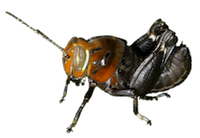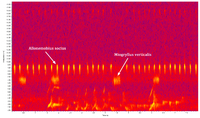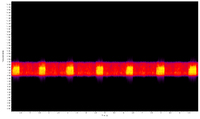Family (Alpha): ACRIDIDAE GRYLLACRIDIDAE GRYLLIDAE GRYLLOTALPIDAE RHAPHIDOPHORIDAE ROMALEIDAE TETRIGIDAE TETTIGONIIDAE TRIDACTYLIDAE
View Gryllidae Members:
Acheta domesticus Anurogryllus arboreus Gryllus unidentified species Gryllus firmus Gryllus fultoni Gryllus pennsylvanicus Gryllus pennsylvanicus/veletis Gryllus pennsylvanicus-veletis Gryllus rubens Gryllus veletis Miogryllus verticalis Velarifictorus micado Hapithus agitator Orocharis unidentified species Orocharis luteolira Orocharis saltator Cycloptilum unidentified species Cycloptilum bidens Cycloptilum pigrum Cycloptilum slossoni Cycloptilum tardum Cycloptilum trigonipalpum Cycloptilum velox Myrmecophilus pergandei Allonemobius allardi Allonemobius fultoni Allonemobius griseus griseus Allonemobius griseus funeralis Allonemobius maculatus Allonemobius socius Allonemobius sparsalsus Allonemobius tinnulus Allonemobius walkeri Allonemobius unidentified species Eunemobius carolinus Eunemobius confusus Eunemobius melodius Eunemobius unidentified species Neonemobius cubensis Neonemobius palustris Neonemobius variegatus Pictonemobius ambitiosus complex Pictonemobius ambitiosus Pictonemobius hubbelli Nemobiinae unidentified species Oecanthus unidentified species Oecanthus celerinictus Oecanthus exclamationis Oecanthus fultoni Oecanthus latipennis Oecanthus nigricornis Oecanthus niveus Oecanthus pini Oecanthus quadripunctatus Neoxabea bipunctata Phyllopalpus pulchellus Anaxipha delicatula Anaxipha exigua Anaxipha litarena Anaxipha rosamacula Anaxipha thomasi Anaxipha tinnula Anaxipha tinnulacita Anaxipha tinnulenta Anaxipha vernalis Anaxipha new species near vernalis Anaxipha unidentified species Cyrtoxipha columbiana Falcicula hebardi Gryllidae unidentified species NC Records
Miogryllus verticalis (Serville, 1838) - Eastern Striped Cricket
Taxonomy
Family: Gryllidae
Subfamily: GryllinaeTribe: ModicogrylliniSynonym: Miogryllus saussurei Comments: One of twenty-two species in this genus, only two of which occur in North America north of Mexico (Cigliano et al., 2018); verticalis is the sole species in the EastSpecies Status: Walker (SINA, 2018) makes a case for why this species should be called Miogryllus saussurei, the opposite side having been taken by Hebard (1915) and Blatchley (1920). However, it is still listed as verticalis by both SINA and OSF; consequently, that is the name that we are using.
Identification
Field Guide Descriptions: Elliott and Hershberger (2006); Himmelman (2009) Online Photographs: SINA, BugGuide (as M. saussurei), Songs of Insects, Google Images ,
iNaturalist , GBIF Technical Description, Adults/Nymphs: Hebard (1915); Blatchley (1920)SINA 521a.htm Comments: A small, cricket with distinctive head markings. The head is large, globe-shaped, and shining black. Pale lines encircle the eyes and extend to the rear margin of the head; four short longitudinal pale lines are also located at the rear of the occiput. The head markings are similar to those of Velarifictorus micado but lacks the continuous white line that connects the antennal bases in that species. The head is also less globose in micado and its palps are white rather than yellowish with a dusky tip as in verticalis.Total Length [body plus wings; excludes ovipositor]: 10-16 mm, males; 11-17.5, females (Hebard, 1915)Structural Features: According to Hebard (1915), both macropterous and micropterous individuals exist; Blatchley (1920) mentions that Brimley collected a long-winged form in Raleigh. Hind tibiae are two-thirds or less the length of the hind femora (longer in Gryllus species) and have four to five spines on the outer side (five to eight in Gryllus) (Blatchley, 1920).Singing Behavior: Songs consist of short buzzy chirps separated by intervals longer than the chirps themselves. The chirp rate is highly variable: according to Fulton (1932) 6-11 chirps are produced per minute, but we have a recording where the rate was 42 per minute and SINA has an example from Cumberland County, NC, where the rate was 46 per minute; Allard (1911) also mentions an individual with a rate of 38-39 chirps per minute. Each chirp rises slightly in pitch and amplitude from at least the initiation to the main portion of the trill. The dominant pitch at about 77 F (25 C) ranges from 6.9 - 7.8 kHz (SINA, 2018).Recording playback at normal speed.
Download Video:
"MP4"
Nymphal Stages and Development: Apparently not described, but illustrations on BugGuide show pale lines on the head, which should make them identifiable as this species
Distribution in North Carolina
County Map: Clicking on a county returns the records for the species in that county.
Adult Dates: Click on graph to enlarge
Habitats and Life History
Habitats: Reportedly occupies areas of sparse or short grasses in fairly dry uplands (Blatchley, 1920; Himmelman, 2009). Records from natural habitats include a stand of dry Coastal Fringe Evergreen Forest and a mesic, forb-rich swale in the Sandhills. Records from disturbed or semi-natural habitats include a dry grassy slope under a powerline in the Piedmont, a dry roadside right-of-way in the Mountains, and lawns with sparse grasses in both the Piedmont and Sandhills. Diet: Not recorded but probably omnivorousObservation Methods: Sings mostly at night (Fulton, 1932), but at least occasionally during the morning as late as 9:00 (S. Hall, pers. obs.). The songs are reportedly difficult to localize and individuals are difficult to capture once found (Brimley, 1920).Abundance/Frequency: Appears to be sparsely distributed but can occur in small coloniesAdult Phenology: Fulton (1951) indicates that adults appear in mid-May and persist until early August. We now have records from the end of August, when the populations still appeared to be singing vigorously
Status in North Carolina
Natural Heritage Program Status: Natural Heritage Program Ranks: GNR SNR [S3S5]State Protection: Has no legal protection, although permits are required to collect it on state parks and other public landsComments: We currently have few recent records for this species, but it occupies a wide range of habitats -- including disturbed areas -- and occurs over a fairly wide area of the state. For those reasons, we believe that it is probably relatively secure within the state.
Image Gallery for Miogryllus verticalis - Eastern Striped Cricket Recorded by: Steve Hall Recorded by: Steve Hall Recorded by: Steve Hall, Carol Tingley, and Tom Howard Recorded by: Steve Hall, Carol Tingley, Tom Howard, David George, and Jeff Nizknik Recorded by: Steve Hall Recorded by: Steve Hall Recorded by: Steve Hall, Bo Sullivan, Jim Petranka Recorded by: Steve Hall Recorded by: Steve Hall, Bo Sullivan, Jim Petranka Recorded by: Jim Petranka Recorded by: Steve Hall Recorded by: Steve Hall Recorded by: Stephen Hall and Bo Sullivan Recorded by: Stephen Hall and Bo Sullivan Recorded by: Steve Hall and Bo Sullivan
MP3 Gallery for Miogryllus verticalis - Eastern Striped Cricket 1
Your browser does not support the audio element.
Recorded by: Steve Hall 2
Your browser does not support the audio element.
Recorded by: Jim Petranka

 »
»












